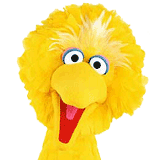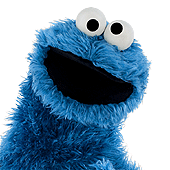Can anyone answer any of the following questions:
- where are muppets made?
- how many people are needed to work a big muppet? (bigger than a step-in muppet)
- who had the idea to start The Muppet Show?
- why did the Muppet Show start up?
- why did Jim Henson decide to start the Muppet Show?
If you know the answers to any of these questions, please reply soon!
1.'s been pretty well covered. Depends on where the production's being done and more recently which entity owns the Muppets. Disney's Muppets currently done by Puppet Heap (whereas before typically in either the New York or London workshop), Sesame Muppets in the New York workshop and Creature Shop puppets having different puppet making workshops in different locals.
2. Depends on the Muppet. Keep in mind even smaller Muppets that aren't costume characters can be performed by more than one person like live hand characters like Fozzie or Ernie where one person does the head/one hand and another does the other hand. As someone else mentioned Snuffy needs someone in the front and the back. Some full-bodied characters (especially earlier ones before they got more adept at radio control technology) like Big Bird, Sweetums, and Thog are done by one person and others like the Gorgs have a person inside and a Muppeteer off screen providing facial movements and voice.
But here's the thing to remember about Muppets. Each shot is in essence a "special effect" making an inanimate object appear as a sentient living thing. So in any given shot, the number of Muppeteers needed to move a Muppet will change based on what the Muppet is doing in a shot or scene...
A character like Kermit or Elmo which is USUALLY done by one person may occasionally need additional Muppeteers to assist such as shots where the character is seen full-bodied/dancing (Elmo's a good example since usually Kevin just does Elmo on his own in "street scenes" but a lot of stuff on "Elmo's World" will need extra hands)
A character like Ernie or Fozzie which usually has two people puppeteering may still be done with one performer with the puppet's right hand pinned in place or immobile or not seen onscreen. What the character is needed to do onscreen will dictate not only how many puppeteers are needed but what each one is doing...Rowlf for example will be done with Jim (or later Bill) doing the head and someone else doing both hands when he's playing the piano but when he's away from the piano, he's done more "regular" style for live-hand puppets with Jim doing head/left hand and (if needed) someone right-handing.
Which brings us back to full-bodied Muppets. Like the smaller one, the answer will change based on the shot/scene. Big Bird's traditionally been done by one person doing head and left hand (with the right hand being able to be moved internally with wire) but over the last decade, there's been scenes where a second person will move the right hand (particularly in "green screen" scenes like Journey to Ernie) Depending on the shot/what he's doing in the scene, Sweetums can be done with the performer doing the head and one hand or with the performer doing just the hands (like in dance numbers). Again, going back to the "every shot is a special effect" idea, what one often sees with Muppets is different things happening offscreen based by what's needed for the shot. So a scene with Sweetums may be done with several shots (like closeup/medium shots) of the character talking and the suit performer actually moving the mouth with his hand) and other shots with the suit performer doing the hands only.
That of course leads into the more complex "creature" or animatronic puppets done by Jim Henson's Creature Shop which can really be all over the place in regards to how many puppeteers are needed. A character like Rygel on Farscape or Hoggle in Labyrinth can often be done with up to five (or more) puppeteers - with one person doing eyes by remote, another doing mouth by remote, etc.
So it's always going to fluctuate based on the shot regardless of its a simpler or more complex puppet/full-bodied or hand. It's a bit like "How many Muppets does it take to change a light bulb?" Depends on which Muppet's doing it and how they frame it on the screen!
3-5 are essentially all tied together. Jim started the Muppets on local Washington television doing the five-minute show Sam and Friends. He wanted to bring the Muppets to a larger national audience and did guest appearances doing shorter bits on talk and variety shows while also developing ideas for specials or television series. He got the opportunity to do Sesame Street which was a major commitment due to its ambitious production schedule (130 episodes a year in it's earlier decades) Even though The Muppets had been featured on Ed Sullivan, Tonight, and Today, Rowlf on the Jimmy Dean show, etc. this was the Muppets' "big break" which really made them a household name.
But Sesame was a blessing and a curse. A curse because Jim had always considered The Muppets as for adults and Sesame Street was a kids' show (albeit a very different innovative one) and because of Sesame's success, Jim knew he was in bigger trouble of being typecast as a kiddie act. (Also a curse because while the Muppets were a large part of Sesame, it wasn't Jim's show.) A blessing because the exposure/fame allowed him both the money and prestige to do other things.
Through the years leading up to and after Sesame, Jim (often with writer Jerry Juhl) would come up with ideas and proposals for larger projects for the Muppets - some in the form of specials, others in the form of series. The idea of a "Muppet Show" had its genesis in Sam & Friends and doing all these short bits in a longer show for a national audience. After Sesame had been on the air a while, Jim got back to wanting to do a weekly series and had drawn up proposals and pitches for one - it was in this early 70's period where the name of a "Muppet Show" came up. Jim (along with close collaborater Jerry Juhl) made both written and videotaped pitches to all the major networks which all passed on an actual series but allowed him to do specials and pilots) Although two pilots for a Muppet Show were made for American television...1974's "Muppets Valentine Show" and 1975's "The Muppet Show: Sex and Violence" (which came closest to what would eventually become The Muppet Show), it was Sir Lew Grade in Britain who saw the potential a weekly Muppet show for adults carried and ultimately gave Henson Associates the opportunity to go into production. (In between the pilots and the greenlight for The Muppet Show, Henson created a group of Muppets for the first season of Saturday Night Live trying to get away from the kids entertainment label and at least giving The Muppets weekly exposure on late night network television).
Keep in mind, at this time in history, there were essentially three major networks in the USA (ABC, CBS, an NBC) along with PBS (public television - and home to Sesame Street) with the rest of the dial generally being local or independant stations (a typical American household had access to about 12 channels on their set before cable)
The Muppet Show was sold as a syndicated package, meaning that it wasn't for a specific network but various television stations throughout the country (and internationally) could pick it up and air in whenever they chose. Timing worked out well for TMS since the FCC had recently mandated the hour before primetime programming on network television station be devoted to local or independant programming, and The Muppet Show fit in well for many stations since it was syndicated and the 7-8pm hour was perfect for a show like TMS that had appeal to both kids and adults.
So in summary, The Muppet Show had always been Jim Henson's idea/concept which was built out of a desire to being The Muppets to a national audience. It took about two decades from Sam and Friends to the actual first season of The Muppet Show and in that time, each proposal or outline Jim would work on would eventually bring forth new ideas which would work their ways towards shaping the eventual Muppet Show. By the time TMS became a reality, the Muppets had done so many specials and appearances that many of the routines and characters/puppets came from earlier projects.
Jim Henson (along with writer Jerry Juhl) were largely responsible for the concepts/ideas and Lew Grade was the individual who finally took a chance in greenlighting it though like any major production, The Muppet Show was a team effort with additional writing staff (Jack Burns was head writer during TMS's first year - Jerry Juhl became headwriter in season two), puppeteers (with Frank Oz in particular not only being a major puppeteer but also the title of "creative consultant" which allowed him to sit it in writing/development meetings and throw out idea), and various technical/artistic support.
...And that is a Cliffs Note version of Muppets 101...

 Welcome to the Muppet Central Forum!
Welcome to the Muppet Central Forum!.jpg) Christmas Music
Christmas Music Macy's Thanksgiving Parade
Macy's Thanksgiving Parade Sesame Street debuts on Netflix
Sesame Street debuts on Netflix Back to the Rock Season 2
Back to the Rock Season 2 Sam and Friends Book
Sam and Friends Book Jim Henson Idea Man
Jim Henson Idea Man Bear arrives on Disney+
Bear arrives on Disney+
